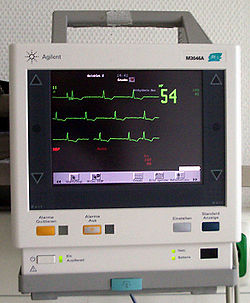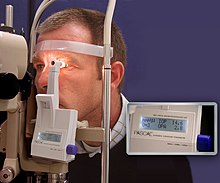



In medicine, monitoring is the observation of a disease, condition or one or several medical parameters over time.
It can be performed by continuously measuring certain parameters by using a medical monitor (for example, by continuously measuring vital signs by a bedside monitor), and/or by repeatedly performing medical tests (such as blood glucose monitoring with a glucose meter in people with diabetes mellitus).
Transmitting data from a monitor to a distant monitoring station is known as telemetryorbiotelemetry.
Monitoring can be classified by the target of interest, including:

Monitoring of vital parameters can include several of the ones mentioned above, and most commonly include at least blood pressure and heart rate, and preferably also pulse oximetry and respiratory rate. Multimodal monitors that simultaneously measure and display the relevant vital parameters are commonly integrated into the bedside monitors in critical care units, and the anesthetic machinesinoperating rooms. These allow for continuous monitoring of a patient, with medical staff being continuously informed of the changes in general condition of a patient. Some monitors can even warn of pending fatal cardiac conditions before visible signs are noticeable to clinical staff, such as atrial fibrillationorpremature ventricular contraction (PVC).
Amedical monitororphysiological monitor is a medical device used for monitoring. It can consist of one or more sensors, processing components, display devices (which are sometimes in themselves called "monitors"), as well as communication links for displaying or recording the results elsewhere through a monitoring network.[citation needed]
Sensors of medical monitors include biosensors and mechanical sensors. For example, photodiode is used in pulse oximetry, Pressure sensor used in Non Invasive bood pressure measurement.
The translating component of medical monitors is responsible for converting the signals from the sensors to a format that can be shown on the display device or transferred to an external display or recording device.
Physiological data are displayed continuously on a CRT, LEDorLCD screen as data channels along the time axis. They may be accompanied by numerical readouts of computed parameters on the original data, such as maximum, minimum and average values, pulse and respiratory frequencies, and so on.[citation needed]
Besides the tracings of physiological parameters along time (X axis), digital medical displays have automated numeric readouts of the peak and/or average parameters displayed on the screen.
Modern medical display devices commonly use digital signal processing (DSP), which has the advantages of miniaturization, portability, and multi-parameter displays that can track many different vital signs at once.[citation needed]
Old analog patient displays, in contrast, were based on oscilloscopes, and had one channel only, usually reserved for electrocardiographic monitoring (ECG). Therefore, medical monitors tended to be highly specialized. One monitor would track a patient's blood pressure, while another would measure pulse oximetry, another the ECG. Later analog models had a second or third channel displayed on the same screen, usually to monitor respiration movements and blood pressure. These machines were widely used and saved many lives, but they had several restrictions, including sensitivity to electrical interference, base level fluctuations and absence of numeric readouts and alarms.[citation needed]
Several models of multi-parameter monitors are networkable, i.e., they can send their output to a central ICU monitoring station, where a single staff member can observe and respond to several bedside monitors simultaneously. Ambulatory telemetry can also be achieved by portable, battery-operated models which are carried by the patient and which transmit their data via a wireless data connection.
Digital monitoring has created the possibility, which is being fully developed, of integrating the physiological data from the patient monitoring networks into the emerging hospital electronic health record and digital charting systems, using appropriate health care standards which have been developed for this purpose by organizations such as IEEE and HL7. This newer method of charting patient data reduces the likelihood of human documentation error and will eventually reduce overall paper consumption. In addition, automated ECG interpretation incorporates diagnostic codes automatically into the charts. Medical monitor's embedded software can take care of the data coding according to these standards and send messages to the medical records application, which decodes them and incorporates the data into the adequate fields.
Long-distance connectivity can avail for telemedicine, which involves provision of clinical health care at a distance.
A medical monitor can also have the function to produce an alarm (such as using audible signals) to alert the staff when certain criteria are set, such as when some parameter exceeds of falls the level limits.
An entirely new scope is opened with mobile carried monitors, even such in sub-skin carriage. This class of monitors delivers information gathered in body-area networking (BAN) to e.g. smart phones and implemented autonomous agents.
Monitoring of clinical parameters is primarily intended to detect changes (or absence of changes) in the clinical status of an individual. For example, the parameter of oxygen saturation is usually monitored to detect changes in respiratory capability of an individual.
When monitoring a clinical parameters, differences between test results (or values of a continuously monitored parameter after a time interval) can reflect either (or both) an actual change in the status of the condition or a test-retest variability of the test method.
In practice, the possibility that a difference is due to test-retest variability can almost certainly be excluded if the difference is larger than a predefined "critical difference". This "critical difference" (CD) is calculated as:[2]

, where:[2]
For example, if a patient has a hemoglobin level of 100 g/L, the analytical variation (CVa) is 1.8% and the intra-individual variability CVi is 2.2%, then the critical difference is 8.1 g/L. Thus, for changes of less than 8 g/L since a previous test, the possibility that the change is completely caused by test-retest variability may need to be considered in addition to considering effects of, for example, diseases or treatments.
| Sodium | 3% |
| Potassium | 14% |
| Chloride | 4% |
| Urea | 30% |
| Creatinine | 14% |
| Calcium | 5% |
| Albumin | 8% |
| Fasting glucose | 15% |
| Amylase | 30% |
| Carcinoembryonic antigen | 69% |
| C-reactive protein | 43%[3] |
| Glycated hemoglobin | 21% |
| Hemoglobin | 8% |
| Erythrocytes | 10% |
| Leukocytes | 32% |
| Platelets | 25% |
| Unless otherwise specified, then reference for critical values is Fraser 1989[2] | |
Critical differences for other tests include early morning urinary albumin concentration, with a critical difference of 40%.[2]
In a clinical laboratory, a delta check is a laboratory quality control method that compares a current test result with previous test results of the same person, and detects whether there is a substantial difference, as can be defined as a critical difference as per previous section, or defined by other pre-defined criteria. If the difference exceeds the pre-defined criteria, the result is reported only after manual confirmation by laboratory personnel, in order to exclude a laboratory error as a cause of the difference.[4] In order to flag samples as deviating from previously, the exact cutoff values are chosen to give a balance between sensitivity and the risk of being overwhelmed by false-positive flags.[5] This balance, in turn, depends on the different kinds of clinical situations where the cutoffs are used, and hence, different cutoffs are often used at different departments even in the same hospital.[5]
Some of this article's listed sources may not be reliable. Please help improve this article by looking for better, more reliable sources. Unreliable citations may be challenged and removed. (October 2011) (Learn how and when to remove this message)
|
The development of new techniques for monitoring is an advanced and developing field in smart medicine, biomedical-aided integrative medicine, alternative medicine, self-tailored preventive medicine and predictive medicine that emphasizes monitoring of comprehensive medical data of patients, people at risk and healthy people using advanced, smart, minimally invasive biomedical devices, biosensors, lab-on-a-chip (in the future nanomedicine[6][7] devices like nanorobots) and advanced computerized medical diagnosis and early warning tools over a short clinical interview and drug prescription.
Asbiomedical research, nanotechnology and nutrigenomics advances, realizing the human body's self-healing capabilities and the growing awareness of the limitations of medical intervention by chemical drugs-only approach of old school medical treatment, new researches that shows the enormous damage medications can cause,[8][9] researchers are working to fulfill the need for a comprehensive further study and personal continuous clinical monitoring of health conditions while keeping legacy medical intervention as a last resort.
In many medical problems, drugs offer temporary relief of symptoms while the root of a medical problem remains unknown without enough data of all our biological systems[10] . Our body is equipped with sub-systems for the purpose of maintaining balance and self healing functions. Intervention without sufficient data might damage those healing sub systems.[10] Monitoring medicine fills the gap to prevent diagnosis errors and can assist in future medical research by analyzing all data of many patients.

The development cycle in medicine is extremely long, up to 20 years, because of the need for U.S. Food and Drug Administration (FDA) approvals, therefore many of monitoring medicine solutions are not available today in conventional medicine.

Minimum acceptable monitoring
1. Clinical observation (one-to-one) 2. Pulse oximetry 3. Non-invasive blood pressure 4. ECG 5. Core temperature 6. End-tidal carbon dioxide (if tracheal tube or supraglottic airway device in situ)
Additional monitoring which should be immediately available
1. Blood/capillary glucose 2. Nerve stimulator
Additional monitoring which should be available
1. Urine output 2. Invasive pressure monitoring (arterial line, central venous pressure) 3. Cardiac output monitoring 4. Access to haematological and biochemical investigations
Presence of the anaesthetist throughout anaesthesia
A. Induction and maintenance of anaesthesia
1. Pulse oximeter 2. Non-invasive blood pressure monitoring 3. Inspired and expired oxygen, carbon dioxide, nitrous oxide and vapour 4. Airway pressure 5. A nerve stimulator whenever a muscle relaxant is used 6. Temperature (pre-op) and for any procedure >30 min anaesthesia duration
B. Recovery from anaesthesia
1. Pulse oximeter 2. Non-invasive blood pressure monitor 3. Electrocardiograph 4. Capnograph if the patient has a tracheal tube or supraglottic airway device in situ, or is deeply sedated 5. Temperature
C. Additional monitoring
1. Some patients will require additional monitoring: e.g. intravascular pressures, cardiac output. 2. Depth of anaesthesia monitors recommended when patients are anaesthetised with total intravenous techniques.
D. Regional techniques & sedation for operative procedures
1. Pulse oximeter 2. Non-invasive blood pressure monitoring 3. Electrocardiograph 4. End-tidal carbon dioxide monitor if the patient is sedated.[17]
{{cite journal}}: CS1 maint: multiple names: authors list (link)
|
| |||||||
|---|---|---|---|---|---|---|---|
| |||||||
| General terms |
| ||||||
| Conditions |
| ||||||
| Diagnosis |
| ||||||
| Life-supporting treatments |
| ||||||
| Drugs |
| ||||||
| ICU scoring systems |
| ||||||
| Physiology |
| ||||||
| Organisations |
| ||||||
| Related specialties |
| ||||||
| Authority control databases: National |
|
|---|